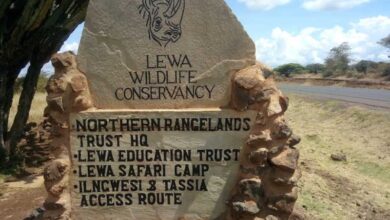
Wasini Island is surrounded by pristine coral reefs and therefore offers an amazingly beautiful underwater world – ideal for snorkeling or diving.
Besides being one of the best snorkeling and diving areas along Kenya’s coast, the waters around Wasini are home to two species of dolphins: the gregarious bottlenose dolphin and the more elusive humpback dolphin. Both dolphin species can be spotted in the vicinity of Wasini whereby the humpback dolphin is more likely to be seen very close to Wasini’s shore, and the bottlenose dolphin generally a bit more offshore. We also regularly spot sea turtles. On occasions, humpback whales can be seen while on their seasonal migration.
Unspoiled, beautiful and sun kissed, the Kisite Marine Park was established to protect the scenic islands and special habitats of a wide range of endemic marine animals and breeding migratory birds. It lies in the coral gardens south of Wasini Island and encompasses three small coral rag forest islands, each with considerable areas of fringing reef. Kisite is one of the most rewarding snorkelling locations at the coast. Visitors can also enjoy bird watching, diving and of course, sunbathing.
Climate
The coast is humid with mean annual temperatures ranging from 22-34 degrees centigrade. Rainfall is around 500mm pa
How to get there
- Location: Kwale District, Coast Province. The Marine Park lies 11 kms off the Kenyan Coast (at Shimoni) and 8 kms north of the Tanzanian boarder.
- Distance from Nairobi: 574 kms.
- Distance from Mombasa: 90 kms
Attractions
The Kenyan Barrier Reef
The most outstanding feature of the Kenyan coast, the pristine and well-developed coral barrier reef extends all the way from Shimoni in the South to Malindi in the North, without significant break, except at the mouths of the rivers. The coral reefs referred to as the rainforests of the sea, are one of the most fascinating ecosystems on earth, sheltering nearly one million types of marine life.
Enchanted Underwater Kingdom
An enchanted realm of living coral gardens, sculpted islands, wheeling seabirds and sparklingly clear waters, this world famous Marine Park promises an underwater world of unbelievable color and vibrancy. The reef provides food and shelter for an entire marine community. A shifting rainbow of small fish, octopus and clams hide in the gaps between the rainbow coral; celestial-blue parrotfish use their hard beaks to chew off lumps of coral while a kaleidoscope of soup plate sized snappers, rubber fish, Sergeant major fish, butterfly fish, angel fish and scorpion fish shimmer in the sunlight of the clear waters. Hunting rays, turtles, 1 meter long reef sharks and starfish also prowl the reef in search of prey while moray eels hide in holes alongside small crabs and wrasses (long, spiny-finned fish). Sea cucumbers, brittle stars and numerous species of mollusk also feed on algae of these warm coastal waters. Kisite Mpunguti Marine protected area features 252 species of reef fish, about 56 genera of hard corals, 2 common species of sea grass and numerous sponges.
Turtle Territory
The Park is famous for its population of turtles: Green and Hawksbill turltes normally spotted in their hang out , Kijamba cha Kasa.
Dolphin and Whale Spotting
The reef offers sanctuary to over 200 dolphins (spinner, humpback and bottle-nosed), which can be encountered as single individuals or mostly in pods of 2-25 individuals breaking above the waves. If you are fortunate enough to visit between July and December, you’ll have a chance to spot Humpback whales, which raise their calves in our warm waters, and migratory Whale sharks (the world’s largest fish).
Kisite Island, Realm of the Seabirds
Kisite Island is an Important Bird Area (IBA). IBAs are globally important habitats for conservation of bird populations. Kisite is a flat, treeless rocky outcrop with many patches of grass and surrounded by a magical sandy beach that’s exposed during low tide. This makes an ideal seabird habitat supporting the pelagic-feeders and breeding colonies of roseate and sooty terns commonly arriving to breed in July and leave with their fledglings from September.every year.
Divers and Snorkellers Paradise
Due to its warm shallow waters, exceptional clarity, pristine coral and extraordinary breadth of marine life, the Park and the Reserve offer an excellent dive sites for beginners and professionals. The warm clear waters, spectacular soft corals and kaleidoscopic marine life make this Park one of the finest snorkeling sites in East Africa. The most popular areas lying in the main coral garden towards the outer edge of the Kisite anchorage area are clearly marked with mooring buoys
The Shimoni Slave Caves
Only five minutes walk from Shimoni Pier and well worthy a visit, are the ancient coral caves of Shimoni. They are vast and some portions are filled with fruit and insect feeding bats. Shimoni caves are reputed to extend 5 km inland connecting to the 3 sisters caves. These caves served for centuries as ‘Kayas’ or sacred sites of worship and sanctuary for the local community. Later in the 18th and 19th century, the caves are also believed to have served as the holding areas for the thousands of captured slaves who were in transit to the infamous Arabian slave markets of Zanzibar. The caves, which are run as a community project, are open from 8.30am to 6pm (a small entrance fee is payable at the gate and the moneys collected pay local teachers in primary schools and school fees for needy children).
*Visitor Tip: The best time to snorkel is two hours either side of low tide, when the greatest amount of marine life is revealed. However, its always best to visit Kisite early in the morning when the sea in calm.
*Please avoid standing on or otherwise damaging the live coral.




